Cards In This Set
| Front | Back |
 What is this image? |
Claus
Sluter, The Moses Well, 1395-1406, stone, Chartreuse de Champmol
The Well of Moses (fr: Puits de Moïse) is a monumental sculpture recognised as the masterpiece of the Dutch artist Claus Sluter (1340-1405/6). It was executed by Sluter and his workshop in 1395–1403 for the Carthusian monastery of Chartreuse de Champmol built as a burial site by the Burgundian Duke Philip the Bold just outside the Burgundian capital of Dijon, now in France. |
 What is this image? |
: Limbourg
Brothers, February, Tres Riche Heures of Jean Duke of Berry, Musée
Condé, 1413-1416, Chantilly, France
Important because it gives rare view into the ordinary day to day life of peasants. |
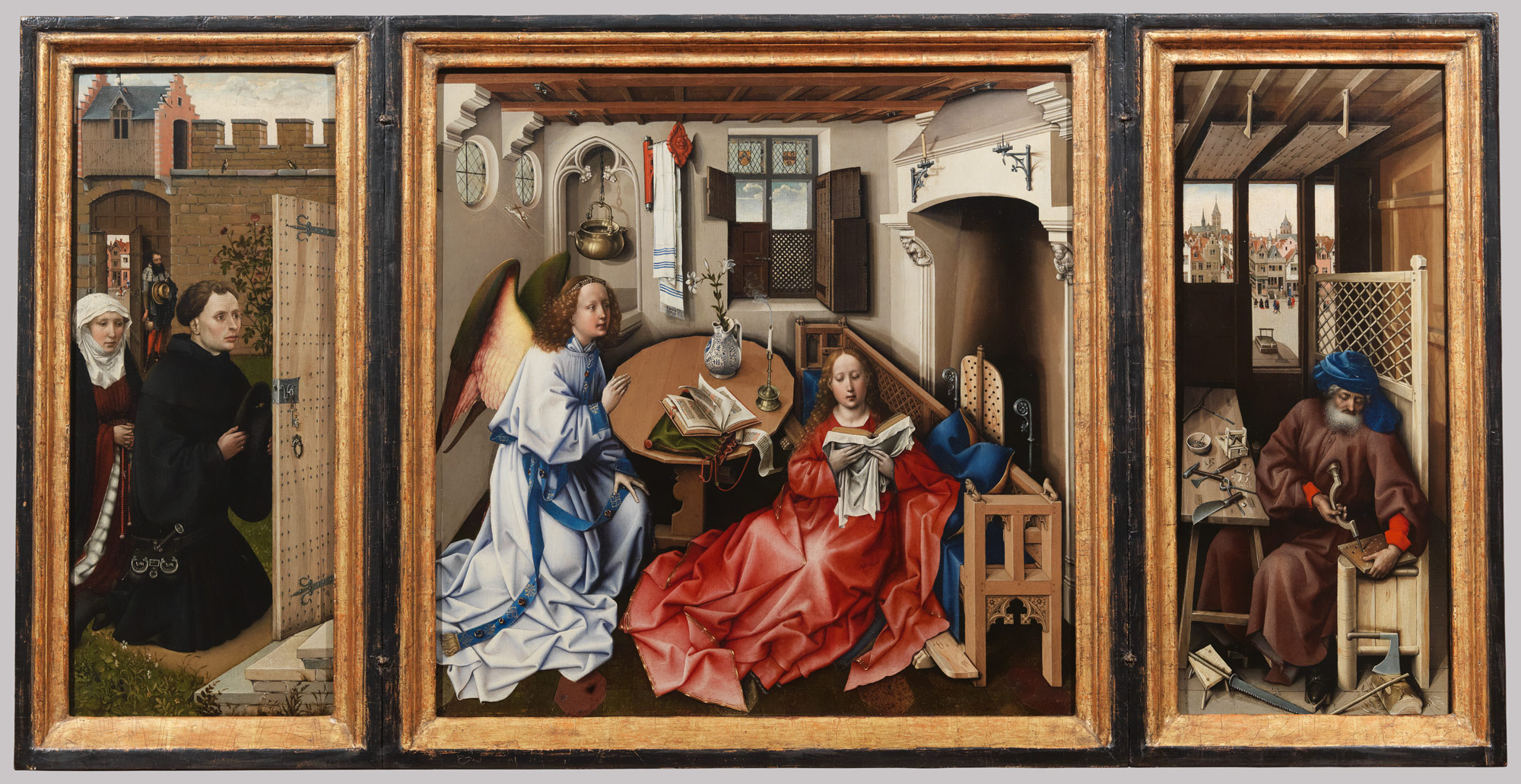 What is this image? |
Robert Campin, Merode
Altarpiece, c. 1425-30, oil on panel, The Metropolitan Museum of art, NY
the three pannels are called a? look at detail of faces. Details story of Christ coming down to Mary and Joseph. Having just entered the room, the angel Gabriel is about to tell the Virgin Mary that she will be the mother of Jesus. Golden rays pouring in through the left oculus carry a miniature figure with a cross. In the right wing, Joseph, betrothed to the Virgin, works in his carpenter's shop drilling holes in a board. The two mousetraps are thought to allude to a line from the Sermones of Saint Augustine: "The cross of the Lord was the devil's mousetrap; the bait by which he was caught was the Lord's death.” In the left wing, the kneeling donor appears to witness the central scene through the open door. His wife kneels behind him as a town messenger stands at the garden gate. The owners would have purchased the triptych as an aide in private devotions. Moreover, an image of Christ's conception in an interior not unlike the one in which they lived may have reinforced their own hope for children. |
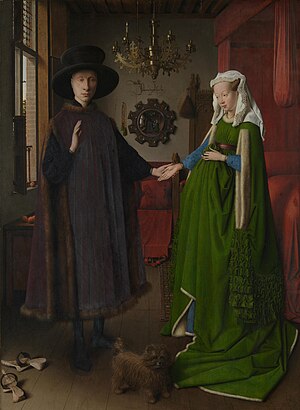 What is this image? |
Jan van Eyck, The
Arnolfini Portrait, 1434, oil on panel, The National Gallery, London
The painting is a small full-length double portrait, which is believed to represent the Italian merchant Giovanni di Nicolao Arnolfini and his wife, presumably in their home in the Flemish city of Bruges. |
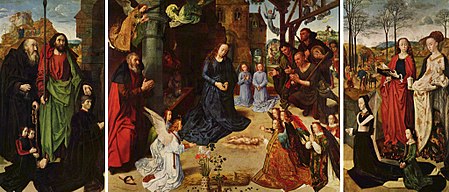 What is this image? |
Hugo van der Goes, The Portinari Altarpiece, c. 1476, tempera and oil on panel,
Galleria degli Uffizi, Florence
In the central panel, three shepherds fall to their knees before the child Jesus. Van der Goes painted these rustic characters very realistically. Kneeling angels surround the Virgin and the Child, who is not in a crib but lies on the ground surrounded by an aureole of golden rays. |
|
What is this image? |
Conrad Witz, The
Miraculous draught of Fishes, 1444, oil on panel, Msee d’Art et d’Histoire,
Geneva, Switzerland
Peter is painted twice once in boat and comming towards christ. The lake isnt from the holy land it's from ____ |
|
Pretend like you're looking at a wood-print.
|
Anonymous artist, The
Martyrdom of Saint Sebastian, c. 1410-1420, woodcut, Staatliche Graphische
Sammlung, Munich
|
|
Another woodcut
|
Buxheim Saint Christopher, c. 1440, (commonly thought to
be 1423), woodcut, John Rylands
University Library, Manchester
|
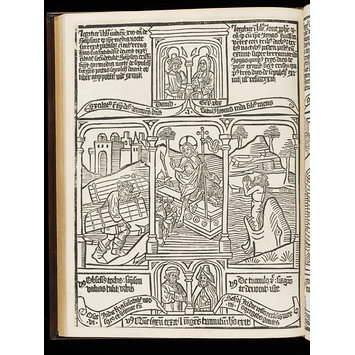 Maybe not right image. |
Anon. Plate i (Resurrection) Biblia Pauperum, blockbook, Germany, c. 1470, British Library,
London
This page shows scenes from the New Testament flanked by parallel scenes from the Old Testament, with quotations at the top and bottom of the page from the Prophets. It comes from a block-book called the 'Biblia Pauperum' (Pauper's Bible). This name has been given to books which tell the story of the redemption of man by Christ, set against prophecies and prefigurations from the Old Testament. Each page of a block-book, text and images, was carved from a single wood-block. The method was very laborious as the maker carved each line and letter out of the wood, cutting away the background. To make the print, paper was rubbed over the inked block from above. Block-books were first made around 1430 and co-existed for decades with books printed with movable type (invented about 1450). This method was economical for very popular works because the block could print large numbers without expensive apparatus such as printing press or type. |
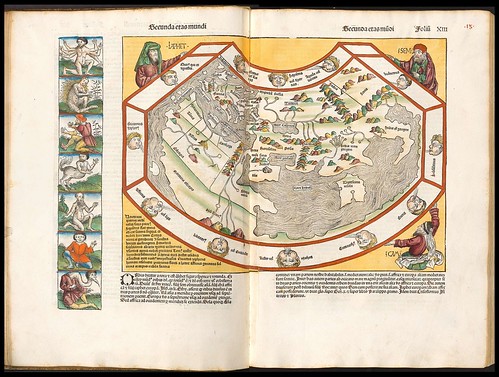 What is this image? |
Michael Wolgemut and Wilhelm Pleydenwurff, View
of Nuremburg from the South, Nuremburg
Chronicle, 1493, woodcut, British Museum, London
|
 What is this image? |
Interior of Upper Church, Basilica of San Francesco,
begun 1228, consecrated 1253, Assisi, Italy
|
 What is this image? |
Saint
Francis receives the Stigmata, 1290’s, fresco, Basilica of San Francesco,
Assisi, Italy
Giotto |
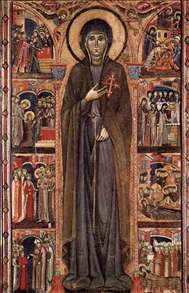 What is this image? |
Altarpiece of
Saint Clare, ca.
1280, tempera on panel, Convent of Santa Chiara, Assisi, Italy |
 What is this image? |
Nicola
Pisano,
Fortitude, detail, Pulpit, 1259-60, marble, Baptistry, Pisa, Italy This statuette is considered the first modern representation of a heroic nude in the Classical manner. It departs from earlier depictions of Hercules in the sculptor's attitude towards the beauty ofthe nude body.Nicola's is at once more classical and more finely carved. Although Nicola's 'Fortitude' is less than a metre tall, it seems more monumental until seen in context. controposto |
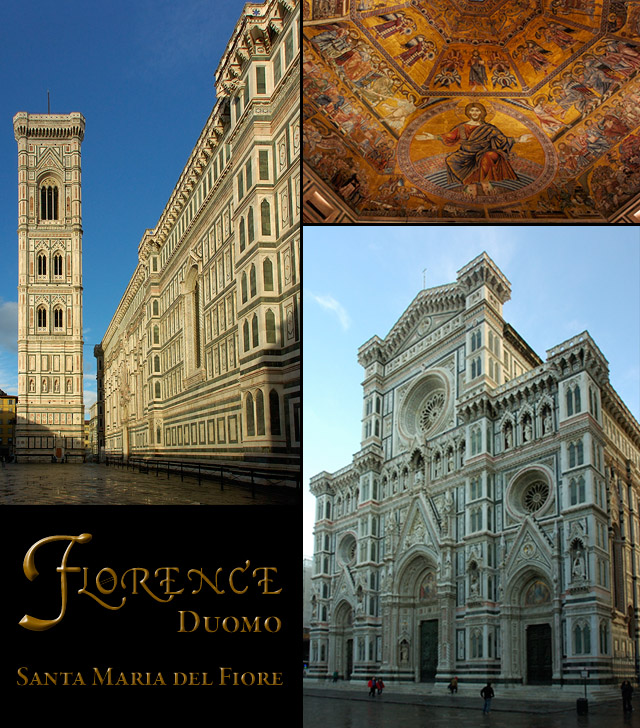 What is this image? |
façade,
Baptistery, Cathedral and Campanile Sta. Maria del Fiore, Florence, Italy The Basilica di Santa Maria del Fiore (English: Basilica of Saint Mary of the Flower) is the main church of Florence, Italy. The Duomo, as it is ordinarily called, was begun in 1296 in the Gothic style to the design of Arnolfo di Cambio and completed structurally in 1436 with the dome engineered by Filippo Brunelleschi. The exterior of the basilica is faced with polychrome marble panels in various shades of green and pink bordered by white and has an elaborate 19th century Gothic Revival façade by Emilio De Fabris. The cathedral complex, located in Piazza del Duomo, includes the Baptistery and Giotto's Campanile. The basilica is one of Italy's largest churches, and until development of new structural materials in the modern era, the dome was the largest in the world. It remains the largest brick dome ever constructed. The cathedral is the mother church of the Roman Catholic Archdiocese of Florence, whose archbishop is currently Giuseppe Betori. |



